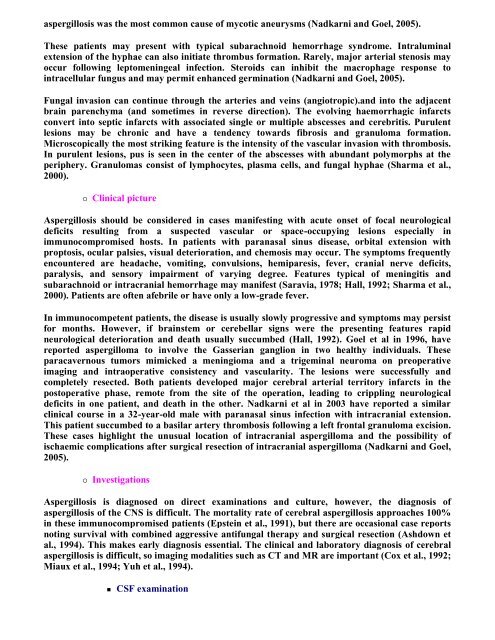INTRODUCTION Granulomatous inflammation is a distinctive ...
INTRODUCTION Granulomatous inflammation is a distinctive ...
INTRODUCTION Granulomatous inflammation is a distinctive ...
You also want an ePaper? Increase the reach of your titles
YUMPU automatically turns print PDFs into web optimized ePapers that Google loves.
aspergillos<strong>is</strong> was the most common cause of mycotic aneurysms (Nadkarni and Goel, 2005).<br />
These patients may present with typical subarachnoid hemorrhage syndrome. Intraluminal<br />
extension of the hyphae can also initiate thrombus formation. Rarely, major arterial stenos<strong>is</strong> may<br />
occur following leptomeningeal infection. Steroids can inhibit the macrophage response to<br />
intracellular fungus and may permit enhanced germination (Nadkarni and Goel, 2005).<br />
Fungal invasion can continue through the arteries and veins (angiotropic).and into the adjacent<br />
brain parenchyma (and sometimes in reverse direction). The evolving haemorrhagic infarcts<br />
convert into septic infarcts with associated single or multiple abscesses and cerebrit<strong>is</strong>. Purulent<br />
lesions may be chronic and have a tendency towards fibros<strong>is</strong> and granuloma formation.<br />
Microscopically the most striking feature <strong>is</strong> the intensity of the vascular invasion with thrombos<strong>is</strong>.<br />
In purulent lesions, pus <strong>is</strong> seen in the center of the abscesses with abundant polymorphs at the<br />
periphery. Granulomas cons<strong>is</strong>t of lymphocytes, plasma cells, and fungal hyphae (Sharma et al.,<br />
2000).<br />
Clinical picture<br />
Aspergillos<strong>is</strong> should be considered in cases manifesting with acute onset of focal neurological<br />
deficits resulting from a suspected vascular or space-occupying lesions especially in<br />
immunocomprom<strong>is</strong>ed hosts. In patients with paranasal sinus d<strong>is</strong>ease, orbital extension with<br />
proptos<strong>is</strong>, ocular palsies, v<strong>is</strong>ual deterioration, and chemos<strong>is</strong> may occur. The symptoms frequently<br />
encountered are headache, vomiting, convulsions, hemipares<strong>is</strong>, fever, cranial nerve deficits,<br />
paralys<strong>is</strong>, and sensory impairment of varying degree. Features typical of meningit<strong>is</strong> and<br />
subarachnoid or intracranial hemorrhage may manifest (Saravia, 1978; Hall, 1992; Sharma et al.,<br />
2000). Patients are often afebrile or have only a low-grade fever.<br />
In immunocompetent patients, the d<strong>is</strong>ease <strong>is</strong> usually slowly progressive and symptoms may pers<strong>is</strong>t<br />
for months. However, if brainstem or cerebellar signs were the presenting features rapid<br />
neurological deterioration and death usually succumbed (Hall, 1992). Goel et al in 1996, have<br />
reported aspergilloma to involve the Gasserian ganglion in two healthy individuals. These<br />
paracavernous tumors mimicked a meningioma and a trigeminal neuroma on preoperative<br />
imaging and intraoperative cons<strong>is</strong>tency and vascularity. The lesions were successfully and<br />
completely resected. Both patients developed major cerebral arterial territory infarcts in the<br />
postoperative phase, remote from the site of the operation, leading to crippling neurological<br />
deficits in one patient, and death in the other. Nadkarni et al in 2003 have reported a similar<br />
clinical course in a 32-year-old male with paranasal sinus infection with intracranial extension.<br />
Th<strong>is</strong> patient succumbed to a basilar artery thrombos<strong>is</strong> following a left frontal granuloma exc<strong>is</strong>ion.<br />
These cases highlight the unusual location of intracranial aspergilloma and the possibility of<br />
<strong>is</strong>chaemic complications after surgical resection of intracranial aspergilloma (Nadkarni and Goel,<br />
2005).<br />
Investigations<br />
Aspergillos<strong>is</strong> <strong>is</strong> diagnosed on direct examinations and culture, however, the diagnos<strong>is</strong> of<br />
aspergillos<strong>is</strong> of the CNS <strong>is</strong> difficult. The mortality rate of cerebral aspergillos<strong>is</strong> approaches 100%<br />
in these immunocomprom<strong>is</strong>ed patients (Epstein et al., 1991), but there are occasional case reports<br />
noting survival with combined aggressive antifungal therapy and surgical resection (Ashdown et<br />
al., 1994). Th<strong>is</strong> makes early diagnos<strong>is</strong> essential. The clinical and laboratory diagnos<strong>is</strong> of cerebral<br />
aspergillos<strong>is</strong> <strong>is</strong> difficult, so imaging modalities such as CT and MR are important (Cox et al., 1992;<br />
Miaux et al., 1994; Yuh et al., 1994).<br />
CSF examination


